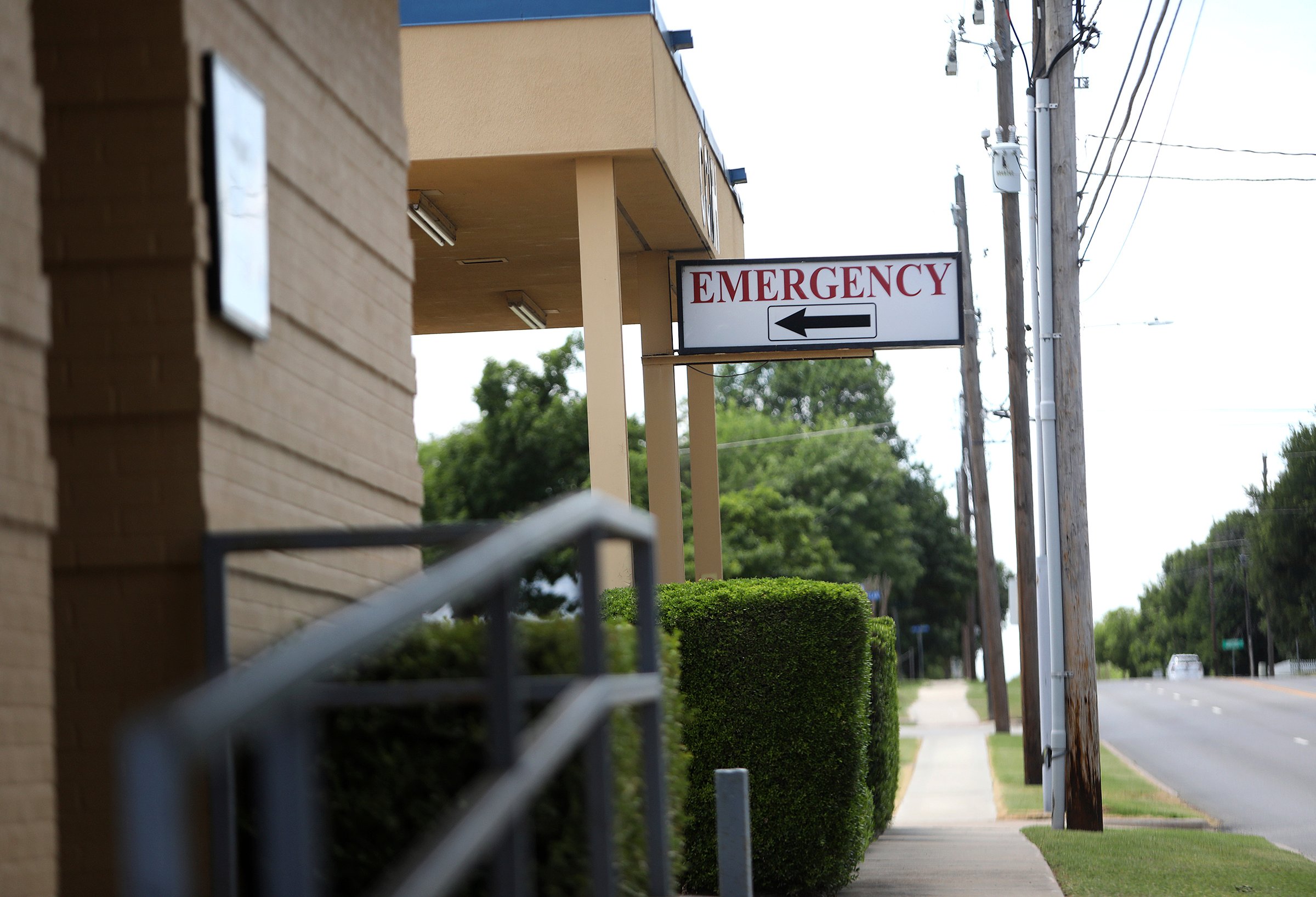
COVID-19 is Surging in Rural Texas, Threatening to Overwhelm Local Hospitals
ICU beds are limited, medical providers are falling sick, and urban hospitals where small facilities transfer critical patients are running out of space.

Just a few weeks ago, officials in Starr County thought their community might make it through the COVID-19 pandemic as one of the few lucky ones. The rural county on the Texas-Mexico border is among the poorest in the United States. There’s only one hospital, a 48-bed facility with no intensive care unit, to serve about 65,000 people. But until June, Starr had just over 30 total confirmed cases of the new coronavirus. Then Governor Greg Abbott began rapidly reopening the state and a wave of new infections swept across Texas counties, including Starr and the rest of the Rio Grande Valley.
Now confirmed cases in the border county have jumped to more than 840, an increase of about 3,000 percent in the last five weeks. The seven-day average of daily new cases has increased from none or 1 before June to more than 40 in early July. Starr County Memorial Hospital had no COVID-19 patients until late June. Last week there were 10; as of this weekend, the hospital beds were full, according to county officials. Demand for testing is so high that the county is no longer covering the cost of tests for uninsured people, who make up about 30 percent of the population. Dr. Jose Vazquez, the local health authority who is also president of the hospital board, worked from home in recent weeks after testing positive in June.
“We have seen other members of our community dying in the Valley hospitals of this disease,” Vazquez told county and city officials on a Zoom call last week. “We are going to be getting sicker patients here in Starr County and needing the ventilatoria systems and ICU services. … We are not ready for this.”
As COVID-19 cases surged across Texas in June and July, Abbott touted hospital capacity statewide to justify reopening. The governor’s stance didn’t mesh with reality, as doctors and hospital administrators warned they were on the verge of being overwhelmed. “We provide care not only to Houstonians,” but also to Texans from many small towns, Faisal Masud, the medical director of critical care at Houston Methodist Hospital told me. “Who’s going to manage them when we are full?”
Public attention has largely focused on major metro hospitals that quickly neared or surpassed ICU capacity in Dallas, Austin, San Antonio, and particularly Houston—home to the largest medical center in the world. But cases are surging in rural areas too, where a relatively small outbreak can overwhelm limited health systems—if they exist at all. To make matters worse, rural hospitals often need to transfer critically ill patients to larger, urban medical centers that are running out of space themselves.
COVID-19 hospitalizations in Texas have grown more than six times since May 25, when many Texans were out celebrating Memorial Day, breaking new records nearly every day for more than a month. A record 9,610 people were hospitalized in Texas as of Wednesday, with a high of 98 new deaths reported since the day before. Abbott’s insistence that hospital beds statewide were plentiful means little in a state as big as Texas: An open bed in El Paso is little help for someone severely ill in Starr County, more than 700 miles away. Regional totals show a dire situation. The nine-county Gulf Coast trauma service region in East Texas, which includes Beaumont and Galveston and is home to 1.3 million people, had a single ICU bed available as of Wednesday. The 12-county Coastal Bend region of more than 630,000 people that includes Corpus Christi had three. In the mostly rural West Texas region spanning 17 counties from the Mexico border to north of Midland and Odessa, where 527,000 people live, there were 27 free ICU beds. And in the four-county Rio Grande Valley, home to nearly 1.4 million people, there were 25.
“We thought we were safe and kind of isolated. Then, boom.”
Rural hospitals across the state have been stretched thin for years, underfunded and understaffed long before the pandemic hit. At least 20 small-town Texas hospitals have closed since 2013, more than double any other state. More than one-fifth of Texas’ 254 counties have just one doctor or none at all. Large swaths of the state, with populations that trend older and sicker, do not have enough hospital beds, health care equipment, specialists, or medical staff to combat an infectious disease outbreak.
Starr County, like much of rural Texas, is facing a perfect storm of challenges when it comes to containing the virus. Testing is still limited, and increased demand is causing lags in getting test results back. Contact tracing—the process of reaching out to those who have had close contact with infected people to advise they get tested and quarantine—is limited across the state. And as more people contract the virus, the few rural doctors and nurses who treat them are also falling sick and quarantining, further reducing capacity.
“It’s getting worrisome to see that we are getting more and more people on a daily basis, and we are also losing employees on a daily basis because they turn out to be positive,” Vazquez said of the Starr County hospital last week. On June 29, two members of the South Texas Congressional delegation sent a letter to Abbott warning that Valley hospitals had reached ICU capacity and urging him reassign the 5,500 National Guard troops stationed at the border to establish field hospitals and assist with medical support in order to “prevent a humanitarian crisis in communities on the U.S.-Mexico border.” A few days later, the county judge announced that the local hospital and others in the Valley were at capacity and that two patients had to be flown to San Antonio and Dallas for treatment. “We are at the point where decisions are going to have to be made in the future about rationing resources,” Vazquez said on July 3, the same weekend the state sent some providers to help with the influx of COVID patients in Starr.
The increasing number of medical professionals catching COVID-19 has exacerbated a perennial problem for the state’s rural hospitals: a shortage of health care workers. In April, when non-urgent hospital procedures were suspended across the state and ER visits were down, Titus Regional Medical Center CEO Terry Scoggin was forced to furlough or lay off 10 percent of the hospital’s workforce due to low revenue. Then in May, amid a spike of cases in northeast Texas, the remaining employees started getting sick—18 employees tested positive for the virus, Scoggin says; two who were in critical condition were transferred 70 miles south to Tyler and placed on ventilators. One died.
Despite the alarming situation, the spike at Titus Regional happened when surrounding urban hospitals had ample capacity to accept transfers of critically ill patients. That’s not necessarily the case anymore. Watching the number of cases tick back up after a lull in June has been “like a suckerpunch to the gut,” Scoggin says. He worries that true case numbers in Titus, which has the fourth highest per capita in the state with 843 cases, are higher than reported, given still-limited testing. “Right now, I’m a little nervous,” Scoggin says. He’s tracking hospital capacity where patients might need to be transferred: Dallas or Tyler, but also Little Rock, Arkansas, and Shreveport, Louisiana. “The craziest thing about this virus is how quickly a patient would go from sick to critical.”
In an effort to free up beds for COVID-19 patients, Abbott in late June again halted non-urgent hospital procedures in Hidalgo, Cameron, Webb, and Nueces counties in South Texas, along with Bexar, Dallis, Harris, and Travis counties a few days earlier. Last week, he issued a statewide mask mandate after weeks of urging from mostly urban county and city officials. In just two weeks, Abbott went from pushing ahead with reopening Texas to closing bars and requiring face coverings—evidence of the pandemic’s severity. (Still, restaurants, gyms, amusement parks, and other businesses remain open, and the governor continues to decline local leaders’ requests to allow stay-at-home orders.) “We’re now at a point where the virus is spreading so fast that there’s little margin for error,” Abbott warned as he announced the mask mandate. “These spikes are not limited to just the big cities. More than 91 counties have had record high numbers in just the last three days.”

In rural far West Texas, it seemed for months like the remote region may be spared a COVID-19 outbreak. But total cases in Brewster County, on the border with Mexico, have skyrocketed recently, from one as of mid-June to 146 now. Brewster has the eleventh-highest rate of reported cases per capita of Texas’ 254 counties. “We thought we were safe and kind of isolated,” says Jim Luecke, a family physician in neighboring Jeff Davis County, who sees patients at Big Bend Regional Medical Center in Alpine, Brewster’s county seat. “Then, boom.”
The rural hospital is the only one in a three-county area of more than 12,000 square miles. It has 25 beds and two ventilators; the closest ICU is 140 miles northeast in Odessa. Generally COVID-19 patients in Alpine are rushed to larger hospitals in Odessa or El Paso, Luecke says; the two- or three-hour drive from one facility to the next makes keeping a patient in Alpine until their condition turns critical a risky endeavor. “Most of the time we’ll try to stabilize in the ER and send ’em off if they’re sick,” he says.
But hospitals in West Texas are also reaching capacity and facing serious staff shortages as providers fall ill. Odessa’s Medical Center Hospital, where at least three Alpine residents with COVID-19 have been transferred for care, stopped accepting patients from outside Ector County, where the hospital is located, for the past week—a move that the hospital CEO acknowledged could force patients in the Big Bend region to travel farther for care. Rural Texans are used to long drives for medical care. But this time, will a hospital bed be waiting for them?
Correction: COVID-19 hospitalizations in Texas have grown more than six times, or more than 500 percent, since May 25. The Observer originally stated hospitalizations had grown more than 600 percent. We regret the error.
Read more from the Observer:
-
Between Borders: From a doctor stranded in Ciudad Juárez to a shelter closed after an outbreak, COVID-19 is hitting hard along the Texas-Mexico border.
-
As COVID-19 Cases Surge, Some Incarcerated People Remain Behind Bars After Making Bail: Electronic monitoring companies refuse to touch coronavirus-positive inmates. That means they can’t go home.
-
Young Texans Keep Spelling Bees Going From Home: When the Scripps National Spelling Bee was canceled in March, two former competitors from The Woodlands stepped up to organize a virtual bee. Now, other bees are following suit.


